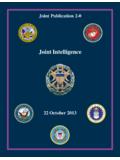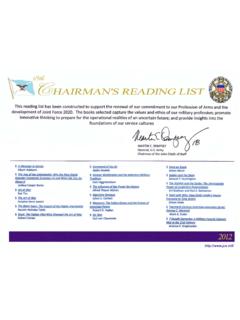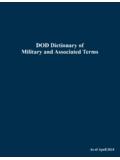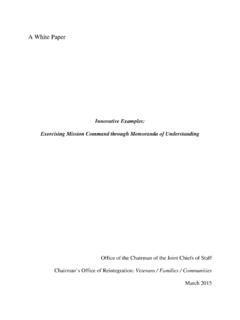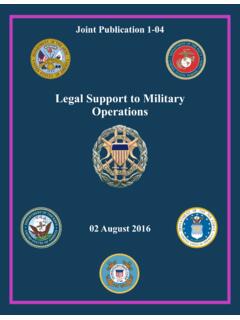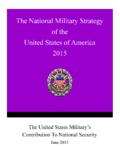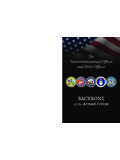Transcription of OPERATION JUST CAUSE - Joint Chiefs of Staff
1 OPERATION just CAUSEThe Planning and Execution of Joint operations in PanamaFebruary 1988 January 1990 Ronald H. ColeJoint History OfficeOffice of the Chairman of the Joint Chiefs of StaffWashington, 1995 Library of Congress Cataloging-in-Publication DataCole, Ronald H., 1943 OPERATION just CAUSE : The Planning and Execution of Joint Operationsin Panama, February 1988 January 1990 / Ronald H. cm. Includes Panama History American Invasion, 1989 Chronology. 2. Military planning United States History 20th century. 3. United States History, Military. I. Title. 199595 49412 3 dc20 CIPiFOREWORDW ritten shortly after the completion of OPERATION just CAUSE , this monographtraces the involvement of the Chairman of the Joint Chiefs of Staff and the Joint Staff inplanning and directing combat operations in Panama. The study begins with the initialdevelopment of contingency plans in February l988 and concludes with General ManuelNoriega s surrender to officials on 3 January l990.
2 Relying primarily upon Joint Stafffiles and interviews with key participants, the author, Dr. Ronald Cole, provides an accountof the parts played by the Chairman of the Joint Chiefs of Staff , the Joint Staff , and theCommander in Chief of Southern Command in planning for operations in Panama andtheir roles in the combat operations that accomplishing his task, Dr. Cole received valuable assistance from a largenumber of the key participants and members of the Joint Staff ; their contributions are notedin the endnotes. The final manuscript was reviewed by Mr. Willard J. Webb and S. Poole, edited by Ms. Penny Norman and typed by Ms. Helga monograph was reviewed for declassification by the appropriate departments and agencies and cleared for release. Although the text has beendeclassified, some of the cited sources remain classified. The volume is an officialpublication of the Office of the Chairman of the Joint Chiefs of Staff , but the viewsexpressed are those of the author and do not necessarily represent the official position ofthe Chairman or of the Joint Chiefs of A.
3 ARMSTRONGD irector for Joint HistoryWashington, l995iiiiiCONTENTSF orewordiOverview1 Chapters1. Background of the 5 Before 5 The Rise of Noriega .. 6 Contingency Planning Begins, February November 1988 .. 7 Nullifying the May 1989 Elections; OPERATION NIMROD DANCER .. 10A Get Tougher Policy: National Security Directive 11 New Leadership and New Plans .. 12 The Failed Coup, 3 October 142. After the Coup Attempt: Accelerated Joint Planning andPreparation, 3 October 5 December 17 General Thurman s Decisions, 3 20 October 17 USCINCSO OPORD 1-90 (BLUE SPOON), 30 October 1989 .. 19 JTFSO OPLAN 90-2, 3 November 22 Rehearsals and a Bomb Threat, 7 October 15 December 1989 .. 243. Trigger Events, The Decision to Interveneand Final Preparations for H-Hour, 15 19 December 27 Trigger Events, 15 16 December 1989 .. 27 Key Military Meetings, Sunday Morning, 17 December 1989 .. 28 Decision at the White House, Sunday Afternoon, 17 December 1989 .. 29ivMonday, 18 December 1989: Movement Preparation,the F-117A Decision, and the Execute Order.
4 30 Tuesday, 19 December 1989: Launching the Airlift .. 324. D-Day, Wednesday, 20 December 37 Opposing Forces .. 37 Actions by the Special operations Forces .. 38 The Conventional Task Forces .. 39 Explanation and Issues in the National Military Command Center:Civil Affairs Reservists, the Media Pool, and 45 Inside the National Military Command Center .. 45 Civil Affairs .. 46 The Media 47 The Hostage Issue .. 496. Last Combat, Civil Affairs, and the Hunt forNoriega, 21 24 December 51 Last Combat with the 51 Civil Affairs and PROMOTE LIBERTY .. 52 The Hunt for 547. The Nunciatura, 24 December 1989 3 January 57An Overview .. 57 Rules of Engagement for Cordoning Off the Nunciatura ..58 Rock Music at the Nunciatura ..59 Contretemps over Cuban and Nicaraguan Diplomatic Privileges .. 60 Negotiations with the 62v8. The End of Organized Resistance, the Shift to Nationbuildingand Redeployment, December l989 3 January 65 End of the Fighting .. 65 Civil Affairs and the Question of Redeployment.
5 669. 71 Some Preliminary Assessments, January April 1990 .. 71 The Impact of Goldwater-Nichols on just CAUSE .. 72 Notes .. 75 Index .. 83 Map of Panama .. 891 OVERVIEWIn the summer and fall of l989, while American attention focused on events inEastern Europe which heralded the end of the Cold War, developments in Panamaraised the possibility of combat much closer to home. operations in Panama would testthe changes to the military command system brought about by the Goldwater-Nichols Defense Reorganization Act of l986. Panama would also try the team at thehead of that system President George H. W. Bush, Secretary of Defense Richard , and the new Chairman of the Joint Chiefs of Staff (CJCS), General Colin , Army. Strengthened by personal relationships formed during earlieradministrations, this team would, in a large measure, determine the operational successof the Goldwater-Nichols about the effectiveness of the Joint Chiefs of Staff (JCS) and thesystem of unified commands had been raised at intervals since the Vietnam War.
6 Inl982 the retiring Chairman, General David C. Jones, Air Force, proposedincreasing the authority of the Chairman and the commanders in chief (CINCs) of theunified commands and strengthening the Joint staffs supporting them. Fueled byreported shortcomings in service cooperation and interoperability during the l983invasion of Grenada and by the role of a cumbersome chain of command in the deathsof 24l Marines in a terrorist bombing in Beirut, criticism of the Joint Chiefs ofStaff system prompted lengthy congressional deliberations and eventual enactment ofthe changes Jones had viewed as the most significant defense legislation since the NationalSecurity Act of l947, Goldwater-Nichols sought to streamline the command and controlof military forces engaged in contingency operations . After designating the CJCSas the President s principal military advisor, the Act made the Chairman specificallyresponsible for the preparation and review of contingency plans a function heperformed in conjunction with the CINCs.
7 It further allowed the President to direct thatcommunications between the National Command Authorities and the commanders ofthe unified commands be transmitted through the Chairman. The CINCs were, in turn,given full combatant command authority over their service components allowing themto control the organization and employment of these forces. OPERATION just CAUSE would demonstrate the effect of these l988, as relations with Panama deteriorated, the commander of SouthernCommand (SOUTHCOM), General Frederick F. Woerner, Jr., Army, haddeveloped a strategy which gradually increased the strength of forces in Panama todeter the dictator, General Manuel2 Noriega, from attacking citizens or interfering with the Panama Canal. Ifdeterrence failed, Woerner planned to bring in additional forces from the United Statesover a three-week period before taking action against Noriega. But after Noriegaoverturned the results of the Panamanian election of May l989, President Bush lostpatience with General Woerner s approach and replaced him with General Maxwell , Army.
8 Aggressive by nature, Thurman modified the BLUE SPOON plan to accommodate a major shift in the strategy for dealing with the buildup of forces in Panama, Thurman also shortened thetimetable for the deployment of additional forces from the to three days. Hoping totake Noriega by surprise, General Thurman intended to overwhelm the dictator s forcesbefore they could organize effective resistance or take citizens took advantage of the CINC s power under Goldwater-Nichols toselect Lieutenant General Carl W. Stiner, Army, the Commander of the XVIIIthAirborne Corps, to command a Joint task force of 22,000 soldiers, 3,400 airmen, 900 Marines, and 700 sailors. General Powell approved Thurman s action. The result was aforce with unity of command and good interoperability which would rapidly achieve itsoperational late l989 relations with Panama grew sharply worse. On l5 December l989,the National Assembly passed a resolution that a state of war existed with the UnitedStates, and Noriega named himself the Maximum Leader.
9 Violence followed the nextevening when a Panamanian soldier shot three American officers; one, First LieutenantRobert Paz, Marine Corps, died of his wounds. Witnesses to the incident, a officer and his wife, were assaulted by Panamanian Defense Force (PDF) soldierswhile in police custody. On 17 December, after a review of these events and a briefingon BLUE SPOON, President Bush decided to act. OPERATION just CAUSE beganshortly before 0l00 on 20 December with special operations forces attacking keyinstallations in the early hours of 20 December, conventional task forces seized additionalkey points and the land approaches to Panama City. Task Force BAYONET thenentered the city, secured the embassy and captured the PDF headquarters, LaComandancia, after a three- hour fight. With the Comandancia in hands andNoriega in hiding, centralized control of the PDF collapsed. However, fighting wouldflare sporadically for some time as forces overcame pockets of General Stiner s force attained its objectives, General Powell became moredirectly involved in military operations due to the growing importance of the politicalaspects of just CAUSE .
10 He did so to ensure3 that actions in Panama meshed with the administration s political and diplomatic the first two days of the OPERATION , Powell told Thurman to accelerate the driveto liberate the Marriott Hotel which held Americans who could become also encouraged Thurman to move quickly to install the legally-electedgovernment of Panama in office to discredit claims that Noriega still governed or military rule was Noriega fled to the papal Nunciatura, troops played loud rock musicoutside the residence. When the Vatican and the diplomatic community complained toPresident Bush about this harassment, the Chairman ordered Thurman to stop the urged Thurman to have members of the new Panamanian government appealdirectly to church officials in Panama and Rome for help in dislodging Noriega from operational success of just CAUSE rewarded efforts by Congress and theBush administration to avoid repeating the mistakes of Lebanon and Grenada. Thedetermination of President Bush and the enhanced authority of the Chairman and CINC combined to provide specific, readily attainable objectives and responsive and effectivecommand and control while giving the tactical commander considerable operationalfreedom.


